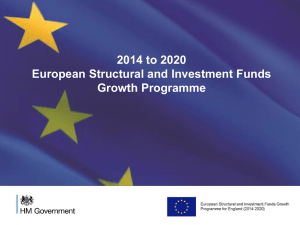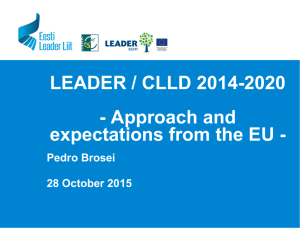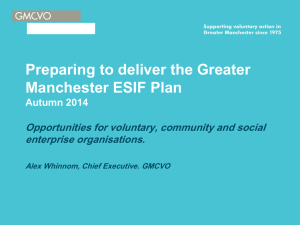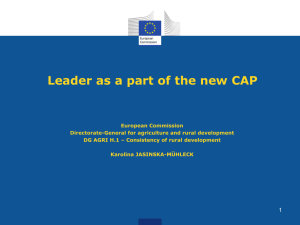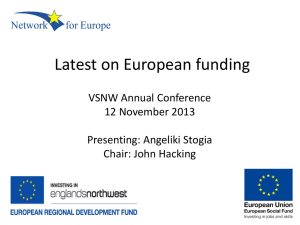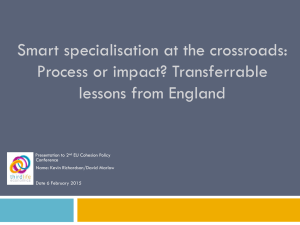Remaining funds in Humber ESIF Strategy
advertisement
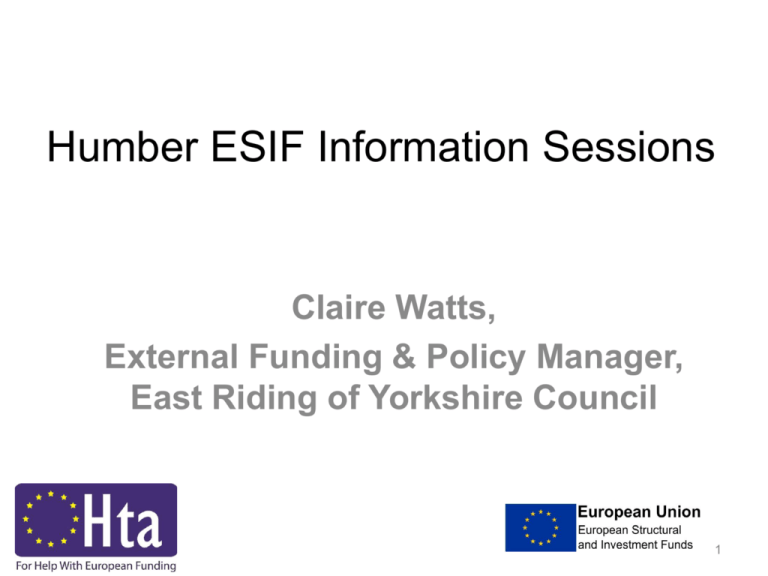
Humber ESIF Information Sessions Claire Watts, External Funding & Policy Manager, East Riding of Yorkshire Council 1 European Structural and Investment Funds SFA Service Offer (the ‘Opt-in’). Agency Role Deliver the ESF element of the ESIF programme on behalf of the Managing Authority. Support LEP area level delivery of ESIF activity. Agency Service Offer • Advise and support LEPs to develop Procurement Initiation Documents (PIDs) • Develop specifications • Procurement (via Bravo) • Tendering and Evaluation Process • Contracting and Managing Providers • Performance Management Process Agency Service Offer • Operate and maintain systems and processes to support delivery • Provide data on activity being delivered • Provide Match Funding • Compile and submit ESF Claims • Ensure compliance with audit requirements • Manage risk. Anticipated Timeline: • Now: Draft specifications being prepared from the Procurement Initiation Documents (PIDS) submitted by LEPs • Now : Applications to Managing Authority for each LEP area. 1 application per Priority per LEP • June/July appraisal of applications conducted by the MA • July: MOUs in place • End July: procurement begins • End October: contracting begins • December: delivery commences ERDF – July 2015 James Trowsdale Investment Manager Humber LEP July 2015 – What’s happened since we last met? – Calls launched in March – Outline Business Plans received and are being appraised – Operational programme agreed https://www.gov.uk/government/publications/draft-europeanregional-development-fund-operational-programme-2014to-2020 Things to think about – Operational Programme highlights what can be funded, but it’s not black and white! – Some activities appear to be deliverable across direct Priority Axes (business support and low carbon type, innovation) – Exchange rates changes (€1 = £0.71 today, at time of writing strategy €1 = £0.85) Summer Priorities – More calls to be released in early August – Community Led Local Development guidance anticipated soon (c£9m) – Access to Finance guidance anticipated soon (c£7m) – Projects being appraised and considered – Strategy to be refreshed What ‘Calls’ will be open in summer? PA1 – Innovation (ESIF strategy budget remaining = £4.14m) PA2 – ICT Support (£2.57m) PA3 – SME Support (£6.4m) PA4 – Low Carbon (£4.56m) PA5 – Climate Change (£10.1m) PA6 – Environmental Protection (£4.42m) Key documents Humber LEP Area ESIF Strategy http://www.humberlep.org/strategies-and-deals/european-structural-andinvestment-funds-strategy/ All calls across England https://www.gov.uk/european-structural-investment-funds ESF draft Operational programme https://www.gov.uk/government/consultations/european-social-fundoperational-programme-2014-to-2020 ERDF Operational Programme https://www.gov.uk/government/consultations/european-regionaldevelopment-fund-operational-programme-2014-to-2020 Name of call PA1 Research and Innovation: call in the Humber Investment Priority 1b - Promoting business investment in research and innovation; developing links and synergies between enterprises.... Funding source ERDF Remaining funds in Humber ESIF Strategy £4.14m Minimum funding application £500,000 Geography all or part of the Humber Research and Innovation • Aims to increase investment in research and innovation by small and medium sized enterprises, particularly in sectors and technologies identified through smart specialisation. • Aim is to support key sectors in the Humber area to drive growth • Energy Estuary • Ports and Logistics • Digital Potential activities – some examples • Support for the commercialisation of new products and business processes and initiatives • Collaborative and contract research • Technology support programmes and demonstrator projects and programmes for current and future technologies • Innovation vouchers • Schemes providing practical, financial and material support for the innovation process within businesses; • Knowledge transfer programmes Name of call PA2 – ICT Support Investment Priority 2b – Developing Information and Communications Technology products and services, e-commerce, and enhancing demand for Information and Communications Technology. Remaining funds in Humber ESIF Strategy £2.57m Minimum funding application Geography £500,000 all or part of the Humber – Focus on areas which have not benefitted previously (e.g. Hull, Grimsby and Scunthorpe) Potential activities – some examples • Support for Small and Medium Sized Enterprises to update or introduce new ICT business models which will drive business performance • Provision of coaching, advice, consultancy, mentoring and support for SMEs to access new markets through improved ICT • Provision of coaching, advice, consultancy, mentoring and support for to develop ICT skills strategies • Provision of coaching, advice, consultancy, mentoring and support for to implement productivity improvements from use of Information and Communication Technology • Demand-side voucher schemes • Demonstration and pilot projects, showcasing how SMEs can stimulate innovation through smart use of ICT • Support for diffusion of results from demonstration and pilot projects • Support for the integration of SMEs in digital supply chains through the smart use of Information and Communication Technology Name of call PA3 – SME Support Investment Priority Remaining funds in Humber ESIF Strategy 3c - Supporting the creation and the extension of advanced capacities for products, services and development £6.4m (£5m outlined for Access to Finance, some projects in appraisal) Minimum funding application £500,000 Geography all or part of the Humber Potential activities – some examples • Provision of advice to develop new business models or higher quality products, processes or services; • Advice and support for businesses to implement productivity improvements including through the provision of resource efficiency advice; • Advice to improve business processes and workforce development; • Advice and support for supply chain interventions to strengthen and grow the domestic supplier base; Potential activities – some examples • Attracting new direct foreign investment into England; • Provision of advice, consultancy support, mentoring, peer to peer support, and support for collaborative projects; • Grant finance for business to invest for product, process and service improvements; and • Provision of independent access to finance advice. Name of call PA3 SME support – International Trade Performance Investment Priority 3d - Supporting the capacity of small and medium sized enterprises to grow in regional, national and international markets and to engage in innovation processes Up to £TBC of funding is available through this call. Funding A minimum value of £500,000 of funding can be applied for. Geography Humber strategy states funding of up to £1m. Humber and other parts of England Potential activities – some examples • Provision of efficient local referral routes to ensure that small and medium sized enterprises are able to identify and access the most appropriate and tailored support for their specific growth needs; • Support small and medium sized enterprises to develop focused growth strategies and update or introduce new business models which will drive business performance; • Advice and support for small and medium sized enterprises to enter, establish and expand in international markets; Potential activities – some examples • Provision of advice, consultancy, mentoring and peer-to-peer support to indigenous businesses; • Leadership and management coaching where connected to the development and implementation of a business growth plan; • Support events, trade fairs and missions to enable small and medium sized enterprises to enter, establish and expand in international markets; • Targeted grant schemes to support productive investment; Name of call PA4 – Low Carbon Investment priority 4b – Promoting energy efficiency and renewable energy in enterprises. Funding source ERDF Remaining funds in Humber ESIF Strategy £4.56m (£2m outlined for Access to Finance) Minimum funding application £500,000 Outline application deadline TBC Geography all or part of the Humber Potential activities – some examples • Enhanced advice, support, information and action to promote innovation in businesses and how they operate, in order to deliver best practice in energy management. This will include innovation in energy efficiency and energy cost reduction to improve businesses’ competitiveness and resilience • Support to businesses to undertake ‘green’ diagnostics or audits of energy efficiency and potential for renewable generation and energy use, which will be followed by provision of energy efficiency information and guidance, tailored energy action plans and of support to implement them Potential activities – some examples • Investing in energy efficiency measures, processes and renewable generation capacity to improve a business’ or building’s environmental performance or its resilience to the impacts of climate change • Supporting increased SME access to national and local government procured contracts for energy efficient goods and services • Developing low carbon innovation in relation to energy efficiency within enterprises, including through technologies and engagement practices Name of call PA5 – Climate Change Investment priority 5d - promoting investment to address specific risks, ensuring disaster resilience and developing disaster management systems. Remaining funds in Humber ESIF Strategy £10.1m Minimum funding application £500,000 Geography Parts of the Humber with high flood risk and potential for economic growth South Humber Bank 6/12/13 Potential activities – some examples • Focus on coastal resilience, fluvial risk management, and Surface water run-off and drainage systems • Managed realignment and mitigation of coastal squeeze • Shoreline re-nourishment, cliff and dune system stabilisation • Improvements to frontages and seawalls • Strengthening and extensions to estuary embankments • Onsite or upstream attenuation and slowing the flow measures • Resilience measures for business infrastructure, including for example wet or dry flood-proofing Name of call PA6 – Preserving and Protecting the Environment and Promoting Resource Efficiency Investment Priority 6b Protecting and restoring biodiversity and soil and promoting ecosystem services, including through Natura 2000 and green infrastructure Remaining funds in Humber ESIF Strategy £4.42m Minimum funding application Geography £500,000 Across the Humber, but opportunity to link with PA5 call Potential activities – some examples • Investment in green and blue infrastructure such as green corridors in urban areas and waterways • Green Infrastructure; definitions are set out in the National Planning Policy and in Natural England’s Green Infrastructure guide • Blue Infrastructure is a sub-set of this and refers to the waterrelated features (rivers, ponds, lakes etc) that play a crucial role in providing benefits to people and wildlife • Sustainable drainage to improve water quality and in some cases local air quality. What calls are being released in overlap areas – Greater Lincolnshire • No ERDF calls until Autumn – York North Yorkshire East Riding • PA1 - Research & Innovation business support call • PA2- ICT infrastructure PA2/3 (TBC) - ICT business support Any questions? Community Led Local Development (CLLD) Claire Watts, External Funding & Policy Manager, East Riding of Yorkshire Council 37 Community Led Local Development (CLLD) • Builds on LEADER ‘bottom-up’ approach used under EAFRD in rural areas but new instrument in context of ERDF and ESF. • Main principles of CLLD set out in Common Provisions Regulation (CPR) and Fund specific Regulations e.g. : CPR Articles 32-35 setting definition of CLLD, content of CLLD strategies, roles of MA and Local Action Groups and scope of ESIF support. • • Thematic Objective 9 Promoting social inclusion, combating poverty and any discrimination. Programmed under Priority Axis 8 of the ERDF OP and Priority Axis 1, Investment Priority1.5 of ESF OP 38 Community Led Local Development (CLLD) • • • • • Scope for CLLD activity is negotiated between MAs and DG Regio and DG Emploi as part of Operational Programmes; New instrument for ERDF/ESF; Optional rather than mandatory approach required by Regulations (the case with LEADER); Not co-financed; Reflects Government’s support for localism and community engagement / ownership in strategies to drive growth and jobs. 39 So what is CLLD? Bottom Up, Focused on sub-regional areas Strategies developed and led by Local Action Groups representing public, private and local socioeconomic interests Driven by local needs and potential and innovative at local level Integrated / Multisectoral area based strategies 40 Community Led Local Development (CLLD) • • • • Territorial cohesion by addressing concentrations of deprivation and disparities in economic performance at lower geographic levels; Focus on need, assets and opportunity to ‘unlock’ growth and jobs potential in deprived areas; Empower communities and devolve decision-making to lowest level – increase community capacity / achieve ‘double devolution’; Targeted approach to area / community in primarily urban and non-LEADER areas. 41 CLLD focus in OPs SME competitiveness innovation (social innovation) Entrepreneurship TO 9 Social inclusion, poverty, discrimination Pathways to integration and access to the labour market, Skills and Employment Reduced social and economic isolation faced by individuals and communities 42 Added Value • Complement and add value to mainstream programme activity; • Embed long term, integrated / place based approaches; • Seeks to build upon local assets and mobilise local resources in a more sustainable manner; • Encourages communities to take ownership and design local solutions to local issues; • Sustained intervention over medium to longer term focussed on the specific needs of a particular area; • Facilitate integrated, multi-fund and multi-sectoral approaches where appropriate. 43 What ERDF/ESF CLLD is not: • Only way to support investment in local development, community/smaller scale projects; • A general community development Priority Axis (i.e. Growth and Jobs focused); • A formulaic funding model and allocation; • Co-financed (matched at source); • A light touch administrative and compliance regime . 44 Issues raised in negotiations with EU: • Must demonstrate the added value of CLLD over mainstream programme activity; • Need to set out value for money, critical mass and rationale for use of CLLD i.e. why use complex methodology involved in CLLD; • Need to demonstrate how CLLD complements mainstream programme activity; • Move from ‘permissive/ allocative’ approach to a competitive approach; • EU views CLLD as a limited specific intervention to address a particular set of circumstances NOT a mainstream delivery mechanism. 45 Following negotiations with the EU CLLD will: • Focus upon sub-regional / sub-LEP areas with population of between 10,000 and 150,000; • Be led by Local Action Groups representing public, private and local socio-economic interests; • Complement but not duplicate LEADER and Fisheries CLLD activity; • Adopt integrated approaches with a minimum threshold of EUR 3m public funding contribution; • Be driven by local needs and potential as identified by the community through the Local Action Group; • Be innovative at local level. 46 Following negotiations with the EU CLLD will: • Provide for a lead fund for management and administration at implementation stage (up to 25%); • Make programme resource available at preparatory and implementation stage; • Have delivered a first wave of CLLD by October 2016 47 Targeting • Transition and More Developed regions => prioritise areas identified as being in top 20% most deprived areas by Index of Multiple Deprivation (2010) • Less Developed => prioritise areas in 30% most deprived by reference to IMD • Scope at margin to link non-IMD adjacent areas to area targeted where demonstrate link need with opportunity, more coherent functional economic geography 48 20% most deprived areas (IMD 2010) 49 Most deprived LSOAs in LEPs in Yorkshire and the Humber Area 50 30% most deprived areas (IMD 2010) 51 ERDF priorities include: • Actions to promote competitiveness of SMEs • Address poor quality local/ small scale business infrastructure • Actions to address lack of amenities, community capacity / social capital and low levels of enterprise / entrepreneurship (including social enterprise) • Poor linkages between areas of deprivation and areas of high economic growth and jobs opportunities 52 Indicative activity ERDF: • Facilitation and capacity building activity in targeted areas that seeks to mobilise community resources and build upon local assets to mitigate risk of social exclusion and act as a foundation for improved economic performance; • Provision of small scale community hub facilities to support SMEs (including social enterprise) in targeted areas; • Promotion of entrepreneurship and self-employment in deprived areas and targeted communities. 53 Indicative activity ERDF: • Tailored business support activity; mentoring; coaching; information, advice and guidance; • Small equipment grants; • Provision of business space; • Support for clustering, networking, cooperating or local supply chains collaboration; • Better connectivity between deprived neighbourhoods and areas of need with areas of opportunity and employment growth; • Support to embed and apply innovation in a local context that builds on community assets in pursuit of jobs and growth; • Support for new forms of enterprise (including the social economy and social enterprise). 54 Key elements ERDF: • Priority 8: Specific Objective: – To build capacity within communities as a foundation for economic growth in deprived areas; • Key outputs: – – – – Number of enterprises receiving support; Number of new enterprises supported; Employment increase in supported enterprises; Number of potential entrepreneurs assisted to be enterprise ready; – Square metres public or commercial building built or renovated in targeted areas. 55 ESF priorities include: • Embedding access to opportunities for growth for all areas and groups; • Addressing persistent levels of unemployment, economic inactivity and poverty, particularly in urban areas; • Promotion of entrepreneurship and access to local services and amenities. 56 ESF priorities include: • Tackling multiple deprivation and work related barriers for those furthest from the labour market. • Reducing employment barriers linked to social and economic isolation, for example by addressing health, debt and money management issues and increasing access to information and advice sources; • Facilitating community participation and engagement and support to address specific issues within local economies – e.g. low level skills 57 Indicative activity ESF: • Innovative activity to tackle multiple deprivation and specific local barriers to accessing employment and skills; • Providing individual pathways to integration and re-entry into employment; • Improving the integration of marginalised families and communities; • Combating discrimination in local areas that are based on gender, racial or ethnic origin, religion or belief, disability, age or sexual orientation. 58 Indicative activity ESF: • Increasing access to information and advice on debt and money management; • Improving low level skills amongst young people NEET and adults, (e.g. communication, ICT and digital skills); • Facilitating community participation and engagement, including community leadership and peer support programmes; • Addressing poor linkages between areas of deprivation with nearby areas of high economic growth and job opportunities. 59 Key elements ESF: • Priority Axis1 (Inclusive Labour Markets) - Investment Priority 1.5 - Specific Objective: – To deliver additional localised support to people in particularly deprived areas, so that they move towards or into employment. • Key results (percentage of): – Unemployed participants into employment on leaving; – Inactive participants into employment, or job search on leaving; – Participants into education or training on leaving. 60 CLLD Strategies • Definition of the area and population to be covered by the strategy; • Analysis of development needs/ potential of the area, including a SWOT analysis; • Description of the strategy and its objectives, innovative features and measurable targets for outputs and results (consistent with fund specific OPs); • Description of community involvement process in the development of the strategy; • Action Plan; • Management and control systems, capacity of the local action group, evaluation; • Financial plan (allocation from each ESI fund). 61 Tasks of Local Action Group • Design and implement CLLD strategies; • Identify lead partner in administrative and financial matters (Accountable Body); • Build capacity of local actors to develop and implement operations; • Draw up non-discriminatory and transparent selection procedure and objective criteria for the selection of operations/ projects, which avoids conflicts of interest, ensuring that at least 50% of the votes in selection decisions are (from) partners which are not public authorities. • Allow selection by written procedure. 62 LAG Tasks • Ensuring coherence with the CLLD strategy when selecting projects, prioritising them according to their contribution to meeting the strategy’s objectives and targets; • Preparing and publishing calls for proposals or an on-going project submission procedure, including definition of selection criteria; • Receiving Applications and assessing them; • Selecting Operations and fixing the amount of support and where relevant, presenting the proposals to the responsible body for final verification of eligibility before approval; • Monitoring the implementation of the CLLD strategy and the operations supported and carrying out specific evaluation activities linked to the CLLD strategy 63 Summary proposals – key elements: • Reflects narrowing of CLLD scope following negotiations with EU Commission; • Encourages integrated CLLD strategies drawing primarily upon ERDF/ESF OPs; • Premised upon a two stage process involving a preparatory stage for each LAG area and CLLD strategy and an implementation stage for which programme resources are eligible; • Proposes use of a delegated grant fund model simplifying MA role and minimising resource implications without losing tasks delegated to LAGs. 64 Next Steps: High level summary Stage 1 Preparatory From summer 2015 • MA develops joint ESF/ERDF Call to develop Local Action Group, CLLD Strategy and identify Accountable Body • MA works with Local ESIF Committee to ensure local strategic priorities are reflected in Call • Call focused on local ESIFs with agreed CLLD framework proposals in local ESIF strategies • MA makes preparatory support available • MA led Selection Committee undertakes assessment / approval of CLLD Strategy, LAG and proposed Accountable Body Outcome of Stage 1 • Accountable Body invited to submit detailed application for implementation of the Agreed CLLD Strategy • Integrated approach ERDF/ESF with lead fund for management and administration • Proposed Delegated Grant Fund Model underpinned by Funding Agreement and MA / applicant management and control, assurance processes Stage 2 Implementation • Accountable Body / LAG led implementation fulfilling EC Regulatory requirements (Article 34) From 2016 • MA / ESIF ongoing monitoring of strategic fit and alignment with ESIF strategy and OP targets 65 Draft Business Process 2014-2020 ESIF Business Process for Community Led Local Development (CLLD) (derogation) LEP Area ESIF Committee Managing Authority Applicant / Grant Recipient Stage 1: Preparatory Stage Sign Funding Agreement to establish LAG, develop CLLD strategy and identify AB Submit Full Application to establish LAG, develop a CLLD strategy, propose an AB Publish Call / Spec (DCLG/DWP in parallel) to develop CLLD Strategy, establish Local Action Groups (LAG) and propose an Accountable Body (AB) GDT/MA eligibility preliminary assessment of FA · Geographic coverage · Rationale relevant against OP(s) · Organisation · Detail preparation costs · Scale (population/£) · 1 month (end Oct) · MA Selects Define local ESIF Strategy .Advise on/ identify local strategic priorities. Alignment to national OP (Operational Programme) Promote opportunities to potential applicants. Moderation MA Agreement to proceed Issues/Approve FA Advise MA on fit of CLLD Strategy in local ESIF and local strategic priorities Successful LAG submits Full Application for implementation of CLLD strategy via AB Establish LAG/AB Develop CLLD Strategy – submitto MA MA led selection committee (rolling basis) Advise MA on fit of CLLD Strategy in local ESIF and local strategic priorities Support Applicants in developing proposals Stage 2: FA and Implementation of CLLD Strategy Approve strategy, invite Full Application for CLLD implementation Date of retrospection for Stage 2 Assessment of Full Application · Capacity / LAG role · Lead Fund / separation of functions · Management Control and reporting · Delegated Grant Fund model · Outputs · Eligibility etc Advise MA on fit of CLLD Strategy in local ESIF and local strategic priorities AB signs Funding Agreement for implementation Implementation via AB/LAG Funding Agreement Delegated Grant Fund Model · · · · · Eligibility Monitoring & Control Reporting Assurance Evaluation Ongoing review of strategic fit and alignment with ESIF Strategy. Monitoring performance in LEP areas against OP targets Version 5 (11 June 2015) 66 Indicative timeline By September 2015 (2 months) By Dec 2015 (2-3 months) By January 2016 (1month) By July 2016 (6 months) • Call Stage 1 Preparatory Costs • Applicant submits Full Application • MA assessment and moderation • MA facilitates advice from Local ESIF committee • Issue and approve Funding Agreement for preparatory costs (£30k-£40k) • Applicant signs Funding Agreement • Preparatory phase leads to development of Local Action Group, Draft CLLD Strategy and identification of proposed accountable body • Applicant submits to MA Indicative timeline By Sept 2016 (2 months) By November 2016 (2 months) By March 2017 (3-4 months) By April 2017 • GDT assessment; MA led Selection Committee (GDT leads/national policy/thematic lead/ independent local economic development expert) • MA facilitates advice from local ESIF • MA approves and invites successful applicants to progress to Stage 2 and submit Full Application • Stage 2 – Applicant (accountable body) submits Full Application for implementation of agreed CLLD strategy (identifying lead fund for management and administration where appropriate) • MA technical appraisal • MA facilitates advice from local ESIF • MA issues Funding Agreement for Stage 2 implementation • Applicant signs Funding Agreement • Implementation Any questions? 69 Technical Assistance (TA) Sarah Clark, Programmes Manager, East Riding of Yorkshire Council What is TA? • Funding from EC to support administration of ESIF • Match funded by applicants/partners • Ensures ERDF and ESF Programmes are managed, monitored and evaluated in line with applicable law and regulations Technical Assistance in the Humber to date • Humber Technical Assistance Phase 1 (Apr 09 - Mar 12) (ERDF 2007-13 Programme only) • Humber Technical Assistance Phase 2 (Apr 12 – Sep 15) (ERDF 2007-13 Programme only) • Delivering one to one and one to many support from project idea to project closedown to any project applicant/manager • Delivering workshops, masterclasses and information sessions, such as this one! ESIF 2014-20 Technical Assistance National Call • National Call for Technical Assistance announced in March 15 • European Regional Development Fund (ERDF) TA and • For the first time European Social Fund (ESF) TA • Applications submitted to deliver both ERDF and ESF across Humber and York, North Yorkshire, East Riding LEP areas Technical Assistance ESIF 2014-20 Technical Assistance Proposed Local Partners Including: • Local Authorities/Councils • FE / HE • Representative organisations of the voluntary and community sector • Representative organisation of the natural environment ESIF 2014-20 Technical Assistance Proposed Eligible Activities Project development and capacity building: • Support to applicants to encourage participation in the ESIF Programme, particularly voluntary, community and social enterprise sector • Support to any applicants during outline application • Support to any applicants during full application stage (subject to MA approval) • Systems and process development advice and support ESIF 2014-20 Technical Assistance Proposed Eligible Activities Project development and capacity building (cont’d…): • Commissioning/undertaking feasibility studies (in exceptional circumstances and subject to MA approval) • Preparatory support for Local Action Groups for the development of Local Development Strategies for CLLD • Other activities deemed necessary by the MA (DCLG for ERDF TA and DWP for ESF TA) ESIF 2014-20 Technical Assistance Proposed Eligible Activities Publicity and promotion: • Awareness raising, communicating programme activities – newsletters, case studies, use of social media • Promoting cooperation, networking and exchange of best practise – LEP areas, nationally and across Europe • Delivering promotional events – seminars, conferences, roadshows to showcase ERDF and ESF achievements and • Publicising bidding rounds – such as this event! ESIF 2014-20 Technical Assistance What happens now? ERDF TA Application • Submitted to DCLG - April 15 • Humber and YNYER ESIF Committees – July 15 • Full application request anticipated - end July 15 • Project starts as HTA2 ends – Sep/Oct 15 ESF TA Application • Submitted to DWP - June 15 • Humber and YNYER ESIF Committees – Aug/Sep 15?? • Full application request could be Sep 15?? • Project starts – Dec 15?? Ask for help! humber-ta@eastriding.gov.uk or 01482 391663
